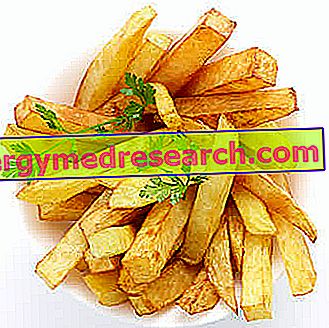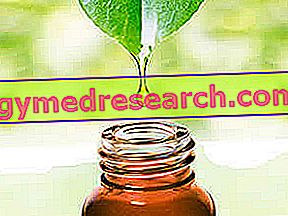Saturated fats
Relationship with vascular diseases
Extraordinary edition: "The legal defenders claim to have burning evidence that butter and eggs, on the bench as defendants of many serious cardiovascular diseases, should be acquitted for not having committed the crime.

We could thus comment on the results of the latest studies on saturated fats and on their relationship with hypercholesterolemia and cardiovascular diseases.
Foods rich in long-chain saturated fats (of animal origin such as eggs, milk and dairy products, butter, fatty meats and raw or cooked sausages) are usually also rich in cholesterol.
Unlike the feared "trans", it seems that saturated fats increase at the same time, albeit differently, bad cholesterol (LDL) and good cholesterol (HDL).
It remains to be determined whether saturated fatty acids are actually less dangerous than "trans" ones or if it is a wrong hypothesis.
Hydrogenated Fats and Trans
Hydrogenated and trans fats are NOT synonymous, although there are often large quantities of the latter where the first ones abound.
What are hydrogenated fats?
The hydrogenated ones are fatty acids which, for commercial reasons, are subjected to an industrial process of "catalytic hydrogenation", which gives them specific chemical-physical properties.
The products that are subjected to hydrogenation are those rich in unsaturated fatty acids, or vegetable oils. Through this process, oils rich in unsaturated fatty acids, monounsaturated (with a single double bond) and polyunsaturated (with more double bonds), are transformed from liquids to solids or semi-solids, increasing their melting point just enough to satisfy application needs.
Ultimately, hydrogenation makes unsaturated fats (mainly contained in vegetables) similar to saturated fats (mainly contained in animals).
The reasons for a similar commercial choice are different, but the main one is economic; it costs less to buy a poor vegetable oil (or a mixture) and hydrogenate it, rather than using a good fat of animal origin.
Moreover, this last category is less conservable and inexorably brings a relevant amount of cholesterol.
Based on what has been said so far, it really seems that hydrogenated fats behave in every way like saturated fats; indeed, almost better!
In fact it would be so, except that during the hydrogenation processes (especially with older technologies) significant quantities of very harmful fats, called trans.
What are trans fats?
"Trans" is the name assigned to a specific configuration of unsaturated fatty acids; the other configuration is called "cis".
As we know, molecules can have the same number of atoms and bonds, but dispose themselves three-dimensionally in different ways, which modifies their metabolic activity / effectiveness.
Trans lipids are to be considered as a "side effect" of hydrogenation.
However, hydrogenated fats are not the only source.
Trans are also naturally present in foods; in particular they are found in milk and derivatives. They are produced by bacteria present in the intestine of ruminants (especially cattle), absorbed and consequently secreted together with milk by the mammary gland. By changing the feed it is possible to change the concentration of trans fats in dairy products.
Lipids subjected to very intense and / or prolonged heat (eg frying oils) also participate significantly in increasing the intake of trans fats.
Ultimately, this particular type of lipid is found in low-cost margarines, in processed vegetable fats and dedicated to fries, and in the foods that contain them (in particular in bakery products such as brioche, breadsticks, crackers, biscuits, in fries in envelope, snacks etc).
Why are trans fats dangerous?
Trans fatty acids ingested with nutrition are considered the real killers that negatively upset cholesterol levels in the blood and increase the risk of atherosclerosis.
The dangerousness of these fats derives from their ability to raise total cholesterol levels, while lowering good cholesterol levels; consequently, they increase the cardiovascular risk.
Many of the products containing hydrogenated (or transesterified) fats are advertised as "0% cholesterol", causing the inexperienced consumer to make a choice that is anything but healthy.
Indeed, if these fats are 100% of vegetable origin (margarines often also contain a good percentage of poor quality animal fats), the product is cholesterol-free, but rich in the far more dangerous trans fatty acids.
Defending against these dangerous "nutrients" is not difficult, as by law the producer is obliged to declare its use on the label, adding the words "totally hydrogenated" or "partially hydrogenated" as appropriate.
It is recommended that you take as few trans fats as possible or that they make up a maximum of 1% of the diet (WHO recommendations, FAO and EFSA).
| Main trans fatty acids |
| Myristelaidic acid |
| Palmitelaidic acid |
| Petroselaidic acid |
| Elaidic acid |
| Vaccenic acid |
| Cetelaidic acid |
| Brassidic acid |
| Linolelaidic acid |
Partially Hydrogenated Fats
Partially hydrogenated fats: are they really different from hydrogenated ones?
To keep cholesterol under control, it is first of all necessary to exclude from the diet products among whose ingredients appear the words "partially hydrogenated" and / or "hydrogenated".
The term "partially hydrogenated" fats would seem more harmless than the classic expression "hydrogenated fats", but in reality the two expressions are almost equivalent.
So be careful not to be misled by fake advertisements.
Moreover, trans fatty acids are formed mainly when the hydrogenation process is NOT completed (for example in the production of margarine); one more reason to exclude them completely from the diet.
Non-Hydrogenated Plant Fats
When instead the label underlines the presence of "non-hydrogenated vegetable fats" the situation is certainly better, but still far from being healthy; often, in fact, poor quality oils are used, like many of the tropical ones, which besides being rather cheap, are rich in saturated fats (for example palm kernel oil and palm oil).
Fortunately, from 13/12/2014 it is mandatory to specify on the label the origin of the oils and / or vegetable fats used (eg olive oil, soy oil, etc.); it is therefore not sufficient to report the generic word "vegetable oils" or "vegetable fats", behind which in the past often the use of poor raw materials was hidden.



